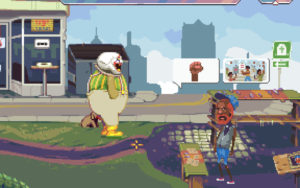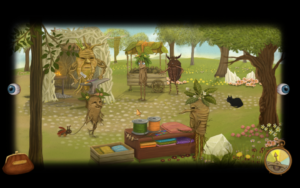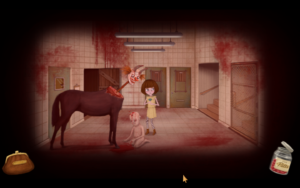Dropsy: Hugs and Aliens
Now, I still haven’t finished Dropsy, so I could turn out to be wrong about this, but: It seems like most of the puzzles around befriending people are in the nature of optional side-quests. Advancing the story does require gaining cooperation from certain people, I think, but for the most part, you’re expected to simply want hugs for their own sake. Although if that’s not enough, the game does provide one other motivator for completists: there’s a record of everyone you’ve hugged, in the form of crayon drawings on a wall of the clown’s bedroom. This gives it a definite “Gotta hug ’em all!” aspect.
It also reminds me a little of The Witcher and its sexual conquest cards that drew so much attention. I was contemplating making that comparison into the basis for an entire blog post, exploring the question of what the difference is, but on reflection, it’s hardly even a question worth asking.
There are a few drawings already on the wall at the start of the game, of those that the clown has already had ample opportunity to hug: the clown’s green-haired colleague, their deceased friend, the dog. Yes, animals count. So does any sufficiently-huggable inanimate object, such as a statue or a tree. There’s one drawing that kind of puzzles me, though: it shows what looks like some kind of squidlike alien. 1UPDATE: It turns out to actually be a rather impressionistic depiction of a security robot from the corporate HQ lobby. Now, there is definitely an alien presence in the game. Off in the desert, there’s a guy in a camper-converted-into-a-storefront trying to sell merchandise related to his personal alien encounter, while a beefy man in black hovers nearby. Elsewhere, in a mysterious cave, I can catch a few glimpses of the very same tentacled being as in the camper man’s pictures, lurking but not particularly trying to hide its presence. The thing is, though, I haven’t hugged the alien, or any other aliens — unless it’s an alien shapeshifter. Maybe I could figure out who’s secretly an alien by process of elimination: it would be the one person who I’ve hugged who isn’t in any of my drawings. But that would have a strange implication: that the clown, who’s presumably the one making the drawings (although goodness knows when he finds the opportunity) saw the shapeshifter’s true form while I, the player, saw only its disguise. So more likely it’s just a bug.
| ↑1 | UPDATE: It turns out to actually be a rather impressionistic depiction of a security robot from the corporate HQ lobby. |
|---|
 Comments(0)
Comments(0)


